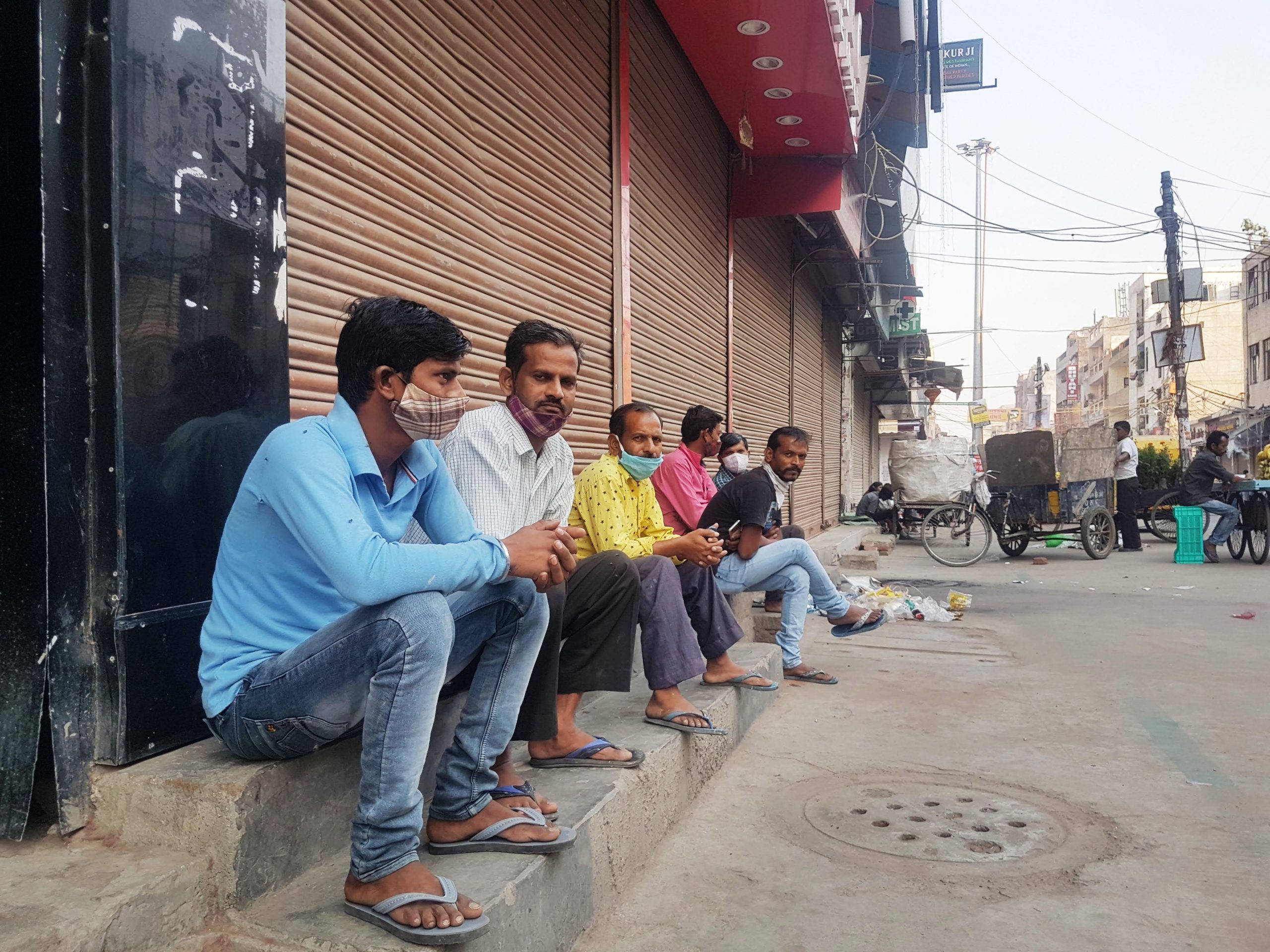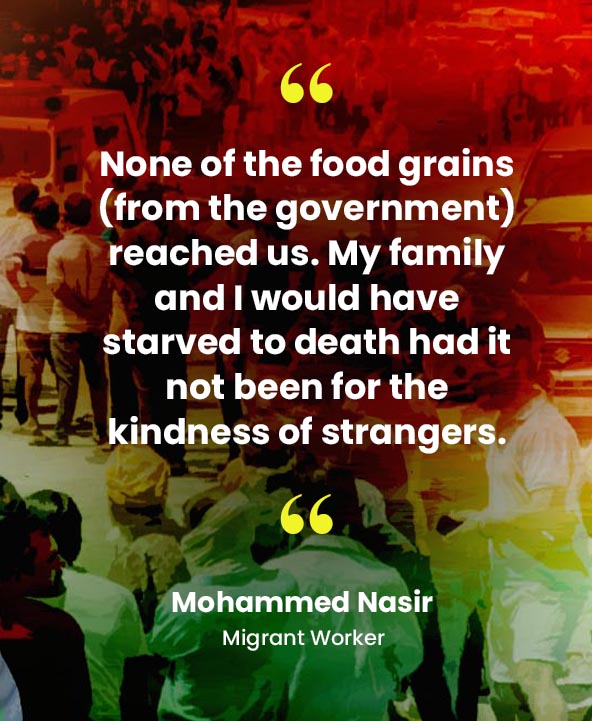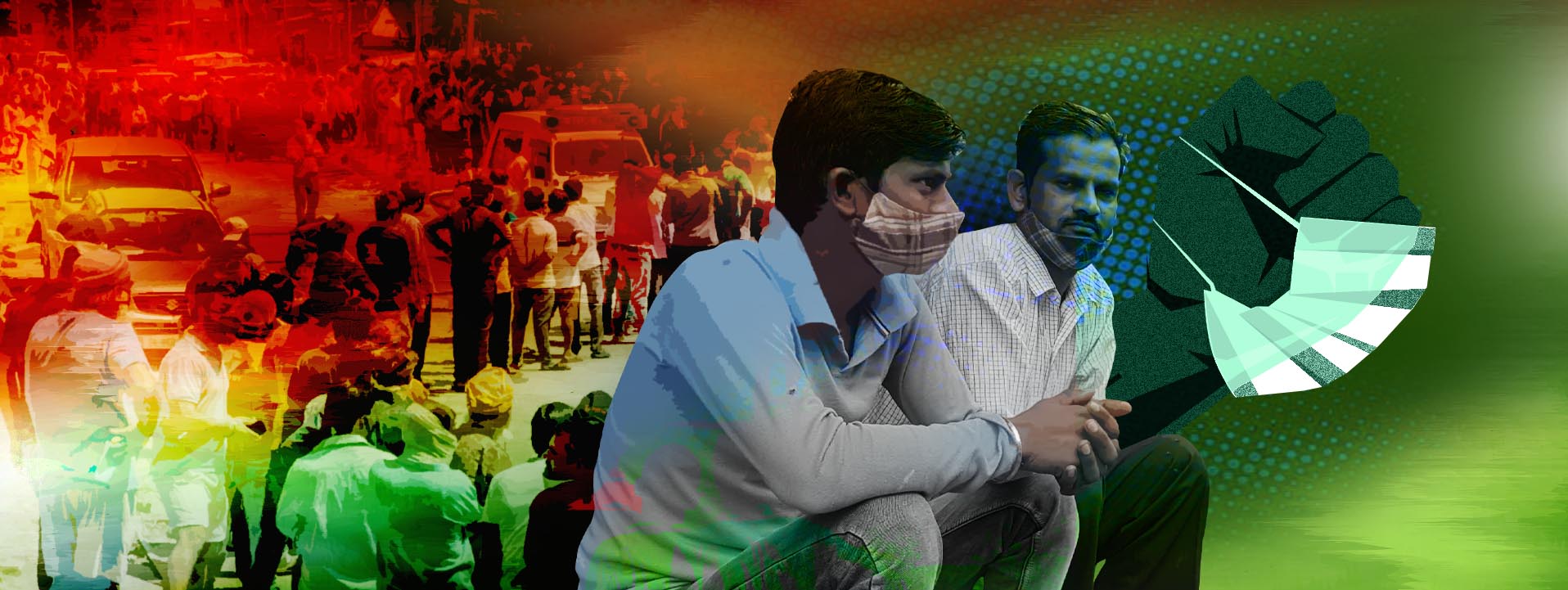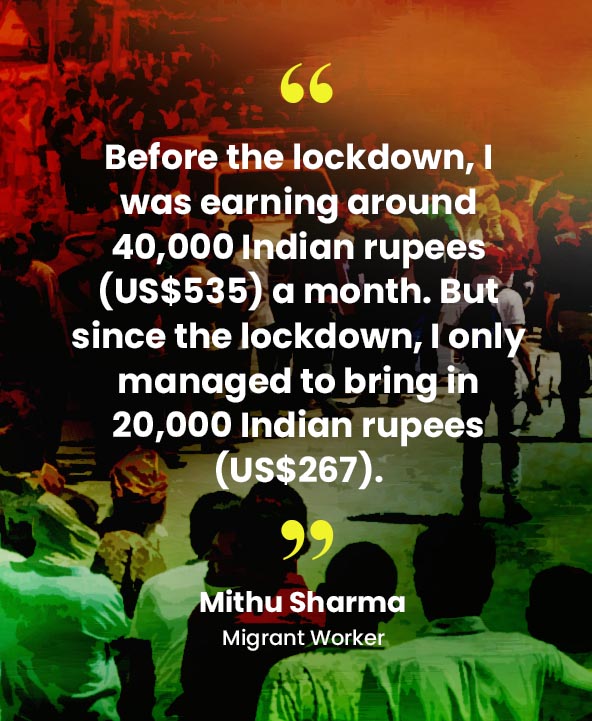Every morning, Arvind Yadav picks up his tools and leaves his house, a small two-bedroom apartment that he and his family of five share with another family. He makes his way to a major traffic crossing. By 8 a.m., he sits down on the pavement at this crossing, which has earned the moniker “Labor Chowk” (Labor Crossing).
Situated in the city of Noida, a satellite town of India’s capital Delhi, this Labor Chowk is the spot where manual laborers—such as stonemasons, house painters, and carpenters—gather every day. They number from a few hundred to a thousand workers.
Yadav recalled how, when times were better, he would walk to Labor Chowk “like a king” and contractors would fight over who gets to hire him for the day. “I would find work in minutes,” Yadav said with pride.
Not anymore, though. “I have been sitting here for the last 11 days,” he said. “And nobody has come to me with any work.” Like countless migrant workers, Yadav worries about how he and his family will survive.

Workers from Bihar wait to get hired at a Labour Chowk in East Delhi. Labor Chowk is the spot where manual laborers—such as stonemasons, house painters, and carpenters—gather every day. Nowadays, work is hard to come by. Photo by Uday Rana
Internal immigrants
On March 24, 2020, Prime Minister Narendra Modi imposed a national lockdown, which forced factories, offices, and educational institutions to close with only four hours’ notice. Modi’s address triggered panic among workers in India’s informal sector. Overnight, Indian TV screens were flooded with images of endless caravans of workers on foot. Buses and trains were shut down, and state borders were closed. Migrant workers, many of whom come from villages nearly 2,000 kilometers away from their workplaces, made the long trek home.
According to 2017 data from the World Economic Forum, around 139 million Indians are internal migrants. They leave their place of primary residence to work in major industrial hubs like Delhi and Mumbai. A World Bank estimate put the number of migrants displaced by the lockdown at 40 million.
But many migrant workers, like Yadav, chose to heed Modi’s call. They had faith that the government would provide them with a safety net so they could spend the lockdown in the confines of their homes while the nation’s economy came to a grinding halt.
Sadly, Yadav, like many others, was disappointed. The last six months have been a trying time for him. He has only managed to earn 12,000 Indian rupees (US$160) between March and August.
Mithu Sharma, who is originally from the eastern state of Bihar, now lives in Delhi. When Modi announced the lockdown, Sharma’s income slowed to a trickle. “Before the lockdown, I was earning around 40,000 Indian rupees (US$535) a month,” he said. “But since the lockdown, I only managed to bring in 20,000 Indian rupees (US$267).” In short, Sharma’s total income in five months is half of what he used to earn in a single month.
No easy options
Sharma, too, considered going back to his home state. It would’ve been a journey of around 1,000 kms from Delhi to the town of Nalanda in Bihar. But when he got down to planning his trip, he saw no viable option.
Sharma said, “Every day I woke up to reports of people like me dropping dead during the walk home. Some died after a car mowed them down, some died of exhaustion, and others faced police brutality on the road.”

On May 1, the government started special train services for migrants. But Sharma heard horror stories of crowded railway stations and poor facilities inside the trains. He said, “There were even reports of people dying inside the trains. I considered all my options and realized that my best bet was to stay put.”
However, as Rajender Kumar found, staying put was not an easy option for workers either. Kumar said, “For four months, I had no income,” he said. “Then, just as the other workers were excited about getting back to work, I had a terrible fall and broke my leg.” Kumar has not done a single day’s work in the past six months.
Kumar’s family was forced to send Suraj, his 16-year-old son, to work. The boy stopped going to school during the lockdown. India does not have a clear plan on when schools will reopen. But whenever they do, Kumar will face a tough decision: whether or not he can afford to pay for the schooling of Suraj. He said, “I pray to God my leg heals by then. I want my son’s life to be better than mine.”
Relief package
Soon after the lockdown, Finance Minister Nirmala Sitharaman announced a US$24-billion relief package for migrant workers. The money was supposed to be used to make direct cash transfer, ensure food security in the lockdown, and set up temporary shelters. But as the testimonies of migrant workers who stayed in the big cities show, the government’s safety net was not wide enough to help everyone.
When Mohammed Nasir heard that the government was going to provide food to impoverished workers such as him, he lined up at a government-run rations shop, but to no avail. “None of the food grains reached us,” said Nasir. He had to rely on a private charity organization that distributed food packets. “My family and I would have starved to death had it not been for the kindness of strangers,” he said.
Four days into the lockdown, the government ordered landlords to waive the rent for the duration of the lockdown. However, the landlords only delayed the rent and compounded it. Sharma said that he pays 8,000 rupees (US$107) in monthly rent. Since he had no work, he couldn’t pay his landlord for the last several months. Sharma now has to pay his landlord all the rent that he owes him or else his family would face eviction.
Police brutality
Social media feeds in India were flooded with videos and pictures of police brutality against the migrant workers who were trying to get home. In the western state of Gujarat, which is Modi’s home state, police reportedly beat up around 120 workers. They were loaded into trucks and then dropped off in Maharashtra.
Even those who stayed in the cities said that they had to suffer violence at the hands of police. Kamal Kishor is from the state of Madhya Pradesh, but lives in Delhi. He said, “I got a call from home and the network in my room was very poor. So I stepped out on to the street for five minutes and a cop started beating me with a baton.” The police said that Kishor violated the lockdown by standing outside the building. Kishor said, “It was the most humiliating experience of my life.”
In July, the government of Uttar Pradesh, India’s most populous state, announced that all weekends in the state would be under lockdown. The policy would put migrant workers like Yadav at a disadvantage.
Yadav said, “Weekends are a busy time for migrant workers because these are the days when people get repairs done in their homes and when we get hired for odd jobs.” However, the police don’t allow the workers to stand at the Labor Chowk for more than five minutes. Yadav said, “When we try to reason with them, they shove us out of our spots.”
Surendra Kumar, who looks for work at the same Labor Chowk as Yadav, said, “We try to be socially distant and wear face coverings. We also understand that the virus is deadly and that poor people are especially vulnerable. But our families would starve if we didn’t head out every day.”
Kumar and Yadav’s sentiments are echoed by other workers. They face a never-ending nightmare as jobs are still hard to come by.
Fault lines
Sharma is worried about his dwindling job prospects. His old jobs, which he booked before the pandemic, were canceled. “When the lockdown lifted, I called my old contacts,” he said. “But all of them canceled the work, saying they weren’t comfortable with having me assemble furniture in their house. Sadly, new jobs are hard to come by.”
The pandemic has exposed the fault lines in India’s beleaguered economy. On September 11, 2020, credit rating agency Moody’s Investors Service on lowered the country’s projected Gross Domestic Product growth rate to minus 11.5% for the financial year 2020-2021.
The country’s economy was already in the doldrums before the pandemic, but migrant workers say the writing has been on the wall for much longer. In November 2016, Modi demonetized high value currency notes in a surprise move. While the aim was ostensibly to crack down on corruption and untaxed wealth, the move created a massive cash crunch in India.
Yadav remembers earning enough for his family to live decently before 2016. However, things have not been the same since then. “Since demonetization, we have not had much work as construction work slowed down,” he said. “I had just started to recover from that shock, but then this pandemic happened. It took four years to recover from that shock. Who knows how long this will take?” ●
Uday Rana is a freelance journalist and writer based in New Delhi, India. You can follow his work on his Twitter handle @UdaySRana.


















